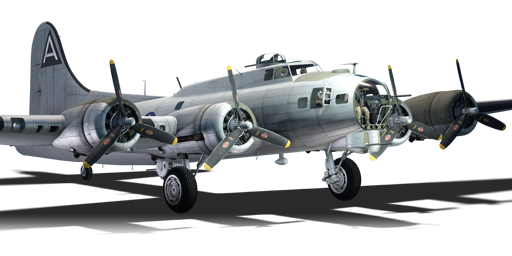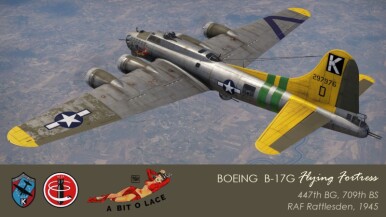



The Boeing B-17G was the main serial production variant of the famous "Flying Fortress" first produced in 1943. Using lessons learned from operating the previous B-17E/F models, several changes were made on the G model, with some carried from the troublesome F model. This included a pressurised cabin, the addition of a chin remote-controlled turret and improved cheek turret mount to counter frontal engagements, moving the right waist gunner position towards to front to increase the overall coverage, improved superchargers for high-altitude operation, and receiving the "Cheyenne" tail turret which increased protection and the field of fire for the tail gunner. Around 8,680 B-17Gs were built, with several airframes being converted as a testbed for various projects.
In the game since the start of the Open Beta Test prior to Update 1.27, the B-17G Flying Fortress, as the name suggests, is intended to be used as a high-altitude level bomber, designed to target enemy airfields and military bases. Compared to the early B-17E models, the B-17G is noticeably faster thanks to improved superchargers, allowing it to climb better and further at higher altitudes. The B-17G's defensive capabilities is also improved, with an addition of chin turret and revised gunner positions that effectively eliminating every blind spots around the plane. In addition, the B-17G also has access to extra wing hardpoints that allow it to carry an extra pair of 1,000 lb and 2,000 lb bombs. All of this allows the B-17G to perform the same job that the B-17E excels at even better than before; destroying ground targets while evading most enemy using altitude advantage, and giving a tough fight to anyone who manages to reach it. However, the B-17G still retains the critical weakness of the "Flying Fortress" family, namely its relatively weak tail, excessive wing loading that restrict its manoeuvrability, and its tendency to catch fire.
flaps
flaps
flaps
brake
| Belt | Belt filling | Armor penetration (mm) at a distance: | |||||
|---|---|---|---|---|---|---|---|
| 10 m | 100 m | 500 m | 1000 m | 1500 m | 2000 m | ||
| API-T/AP/AP/I | 30 | 27 | 20 | 13 | 9 | 6 | |
| AP/AP/AP/API-T | 30 | 27 | 20 | 13 | 9 | 6 | |
| AP-I/I/AP-I/API-T | 28 | 26 | 18 | 11 | 7 | 4 | |
| Belt | Belt filling | Armor penetration (mm) at a distance: | |||||
|---|---|---|---|---|---|---|---|
| 10 m | 100 m | 500 m | 1000 m | 1500 m | 2000 m | ||
| API-T/AP/AP/I | 30 | 27 | 20 | 13 | 9 | 6 | |
| AP/AP/AP/API-T | 30 | 27 | 20 | 13 | 9 | 6 | |
| AP-I/I/AP-I/API-T | 28 | 26 | 18 | 11 | 7 | 4 | |












Flight performance | |
|---|---|
Survivability |
|---|
Weaponry | ||
|---|---|---|
